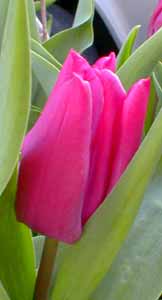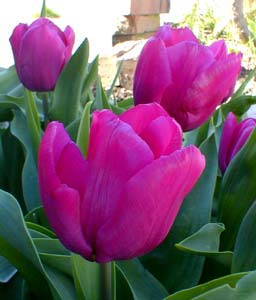
'Purple Prince'
Triumph Tulip
"From the tulip thou seekest
permanence, without avail."
-Abdul Hamid (d. 1732),
Afghanistan
Afghanistan
Registered in 1987 by L. J. C. Schoorl, 'Purple Prince' has become a popular standard of the large-flowered Triumphs. Its outer petals are grape-juice purple or rich bright lilac-purple.
As the bloom ages, a faint lilac-violet flame provides highlights that can make it seem lit from within. The interior is beet-purple with a yellow star in the bottom of the egg-cup. The sturdy stem lifts the flower to a medium height of only one foot or fourteen inches, so it is snuggled in among the large leaves.
 Triumphs began to be hybridized early in the 20th Century from both early & late blooming tulips with an eye to achieving a full range of colors, unusually large blooms, & forcibility so that garden centers could prepare them potted to sell in full bloom by Christmas.
Triumphs began to be hybridized early in the 20th Century from both early & late blooming tulips with an eye to achieving a full range of colors, unusually large blooms, & forcibility so that garden centers could prepare them potted to sell in full bloom by Christmas.Being so easily forced, the single early 'Purple Prince,' even when properly planted as autumn bulbs, will bloom at the first hint of spring, as early as January, though not nearly so early in our garden. For us the buds are fat & purple by the second or third week of March & blooming well before March's end & in April. The photo above from the third week in March shows the freshest new bloom. The second photo shows the drift coming along nicely in the last week of March.
For garden use, they should be obtained as bulbs to be planted in autumn rather than as potted plants already in bloom. When planted from out of pots as already forced bulbs, they are more apt to weaken year by year. Even in the best of cases, Triumphs aren't the ideal tulips for perennializing.
Many Triumphs have Tulipa gesneriana in their heritage, but have passed through a great many generations of hybridization. They are by now so far from their botanical origins that they cannot self-seed or naturalize, & even the individual bulbs can wear themselves out after a few years. For hybrids that really do last for years, Darwins are to be recommended, & for tulips that actually naturalize & spread, botaniucal species tulips are the way to go.
Triumphs make good bedding plants for early-spring brightness of colors. We have a drift of 'Purple Prince' alongside the alley at the corner of the garage. On the carport side of the same alley-side garden, we planted some bright pink & green (Viridiflora) 'Doll's Minuet' which begins blooming two or three weeks after 'Purple Prince,' with a one or two week overlap of blooms. Because 'Doll's Minuet' is a more interesting bloom, it got the side of the garden where we see it as we get in or out of the car, while the more basic 'Purple Prince' puts on its dazzling show for neighbors who pass through the alley, in a spot where I wouldn't want to put anything that was at all delicate.
'Doll's Minuet' & 'Purple Prince' with two flaming red 'Carnival de Nice' peony tulips mixed in, have tucked all about them Muscari latifolium bicolor grape hyacinths. Over their accumulative blossoming heads, wisteria vines dangle from the garage.